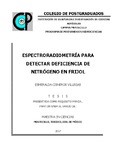| dc.contributor.author | Cisneros Villegas, Esmeralda | |
| dc.creator | CISNEROS VILLEGAS, ESMERALDA; 661670 | |
| dc.date.accessioned | 2019-08-30T14:36:01Z | |
| dc.date.available | 2019-08-30T14:36:01Z | |
| dc.date.issued | 2017-12 | |
| dc.identifier.uri | http://hdl.handle.net/10521/3910 | |
| dc.description | Tesis (Maestría en Ciencias, especialista en Hidrociencias).- Colegio de Postgraduados, 2017. | es_MX |
| dc.description.abstract | La presente investigación se llevó a cabo en el Colegio de Postgraduados, en el periodo comprendido entre julio y octubre del 2017. El propósito fue evaluar y analizar el comportamiento de la reflectancia en el cultivo de frijol a través de la respuesta espectral de éste, en función de la etapa fenológica y sometido el cultivo a diferentes niveles de nitrógeno. Los sensores remotos ofrecen una alternativa viable para la detección de deficiencias nutrimentales, asumiendo que la reflectancia es un indicador del estado de sanidad de los cultivos. El experimento fue establecido en hidroponia en solución, en un diseño completamente al azar, con tres tratamientos (06, 12 y 14 mmolc L-1 de NO3-) a la misma presión osmótica (0.72 atm) y diez repeticiones. Se utilizó frijol var. Flor de mayo que es de semiguía. La recolección de datos de reflectancia se realizó con un radiómetro marca CROPSCAN, mediante el software creado exprofeso, tanto para celular como para computadora. Esta información se analizó a través del índice NDVI (Índice Vegetal de Diferencia Normalizada) correlacionando con altura de la planta, diámetro basal del tallo, número de hojas, número de vainas y área foliar. La radiometría (en particular la reflectancia) provee valiosa información con medidas instantáneas sobre el estado fisiológico de un cultivo. Se observó que este índice puede ser un estimador del rendimiento biológico y agronómico del frijol. Pueden manejarse dosis más pequeñas de las fuentes nutrimentales sin detrimento en la mayoría de las variables respuestas evaluadas. _______________ SPECTRO RADIOMETRY FOR NITROGEN DEFICIENCY DETECTION IN BEAN CROP. ABSTRACT: The present research was carried out at Colegio de Postgraduados, in the period between July and October 2017. The purpose was to evaluate and analyze the behavior of reflectance in bean crops through its spectral response, in function of the phenological stage and given different levels of nitrogen. Remote sensing instruments offer a viable alternative for nutrimental deficiency detection, assuming that reflectance is a health indicator in crops. The experiment was stablished in hydroponics in solution, in a randomized design, with three different treatments (06, 12 y 14 mmolc L-1 de NO3-) at the same osmotic pressure (0.72 atm) and ten repetitions. Flor de mayo bean variety was used which is a creeping plant. The data collection of reflectance was carried out with a CROPSCAN radiometer, trough software designed for this specific project, both for cellphone devices and PC. This data was analyzed using the NDVI index (Normalized Difference Vegetation Index) correlating with plants height, basal stem diameter, number of leaves, number of pods and leaf area. Radiometry (reflectance in particular) provides valuable information with real time measurements about the physiological state of any given crop. It was observed that NDVI index can be an estimator of biological and agronomic yield of bean. Smaller doses of nutrimental resources can be used without a decrease in most of the response variables evaluated. | es_MX |
| dc.description.sponsorship | Consejo Nacional de Ciencia y Tecnología (CONACyT). | es_MX |
| dc.format | pdf | es_MX |
| dc.language.iso | spa | es_MX |
| dc.rights | Atribución-NoComercial-SinDerivadas 2.5 México | * |
| dc.rights.uri | http://creativecommons.org/licenses/by-nc-nd/4.0 | es_MX |
| dc.subject | Reflectancia | es_MX |
| dc.subject | Índice NDVI | es_MX |
| dc.subject | Soluciones nutritivas | es_MX |
| dc.subject | Reflectance | es_MX |
| dc.subject | NDVI index | es_MX |
| dc.subject | Nutrimental solutions | es_MX |
| dc.subject | Hidrociencias | es_MX |
| dc.subject | Maestría | es_MX |
| dc.subject.classification | CIENCIAS AGROPECUARIAS Y BIOTECNOLOGÍA::CIENCIAS AGRARIAS::AGRONOMÍA::SEMILLAS | es_MX |
| dc.title | Espectroradiometría para detectar deficiencia de nitrógeno en frijol. | es_MX |
| dc.type | Tesis | es_MX |
| Tesis.contributor.advisor | Quevedo Nolasco, Abel | |
| Tesis.contributor.advisor | Rodríguez Cruz, Enrique | |
| Tesis.contributor.advisor | Carrillo Flores, Guillermo | |
| Tesis.contributor.advisor | Rodríguez González, Agustín | |
| Tesis.date.submitted | 2017-12 | |
| Tesis.date.accesioned | 2017 | |
| Tesis.date.available | 2017 | |
| Tesis.format.mimetype | pdf | es_MX |
| Tesis.format.extent | 3,294 KB | es_MX |
| Tesis.subject.nal | Deficiencias de nutrientes | es_MX |
| Tesis.subject.nal | Nutrient deficiencies | es_MX |
| Tesis.subject.nal | Cultivos hidropónicos | es_MX |
| Tesis.subject.nal | Hydroponics | es_MX |
| Tesis.subject.nal | Presión osmótica | es_MX |
| Tesis.subject.nal | Osmotic pressure | es_MX |
| Tesis.subject.nal | Radiometría | es_MX |
| Tesis.subject.nal | Radiometry | es_MX |
| Tesis.subject.nal | Estrés de la planta | es_MX |
| Tesis.subject.nal | Plant stress | es_MX |
| Tesis.subject.nal | Conductividad eléctrica | es_MX |
| Tesis.subject.nal | Electrical conductivity | es_MX |
| Tesis.subject.nal | Valor nutritivo | es_MX |
| Tesis.subject.nal | Nutritive value | es_MX |
| Tesis.rights | Acceso abierto | es_MX |
| Articulos.subject.classification | Frijoles | es_MX |
| dc.type.conacyt | masterThesis | es_MX |
| dc.identificator | 6||31||3103||310311 | es_MX |
| dc.contributor.director | QUEVEDO NOLASCO, ABEL; 35175 | |
| dc.audience | generalPublic | es_MX |


